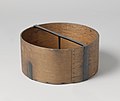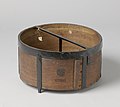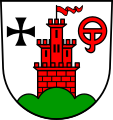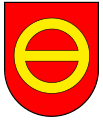Sester
The sester , also sestier , setier , cestier , setiere , sextiere , sextier , sextere , sestiere , sestaire , sesterot , sesterium is an outdated measure of capacity for grain and liquids. Its name is derived from the Latin "sextarius". Different volume sizes were determined depending on the region. The hollow grain size from Baden is 15.0 liters .
In Strasbourg , the old grain measure was divided into rural and urban sester.
- general: 1 sester / sétier = 4 quads = 16 sticks
- 1 Land Sester = 952.723 Parisian cubic inches = 18.8986 liters
- 1 city sester = 923.853 Parisian cubic inches = 18.3259 liters
Before 1872, the Malter was an older grain measure in Switzerland and was also divided into sester. 1 Malter of 150 l or 1.5 hl, divided into 10 quarters or sesters. Sester was also a grain measure for many German states. In Baden, the Malter had 10 sesters of 10 masses and, as in Switzerland, was 150 liters. In the rest of Germany one often converted to bushels .
The little sester was divided as follows in Switzerland ( Canton Basel )
- 1 sester (small) = 4 heads = 8 cups = 32 measuring cups = 861.145 Parisian cubic inches = 17.082 liters
The Vierzel / Vienzel / Viertel had 2 sacks with either 4 large sesters or 8 small sesters.
The Sester Molzermaß was a common name for the meal in the Grand Duchy of Baden . That was the amount of "coated" grain to be paid to the miller as wages. That was 1 / 14th of every sester of grain delivered.
| region | size |
|---|---|
| to bathe | 15.0 liters |
The measuring cylinder for so-called baggy things the size of a sester should have a diameter of 11 inches plus 2 lines plus 2.5 points and for the height 5 inches plus 6 lines plus 1.3 points. For the sester, double semester, half-semester, measuring instrument and cup, these dimensions were laid down in Paragraph 9 of the Dimension Regulations for the Grand Duchy of January 2, 1829.
The Parisian setier (before 1791 ) was equivalent to about 150 liters . An old French septier grain corresponded to 240 poids de marc .
The measure is known from ancient times . The term is based on a computing system based on the value 6 (metric system = 10).
The Schepel is an old Dutch grain measure of 4 Vierdevats = 1/4 Mud or 27.814 Lit., later at times 1/10 Zak = 10 L .; in the Cape 1/4 Mud (English Muid) or 1 Winchester Bushel = 35.238 L.
- Dutch Schepel (around 1800)
heraldry
Various coats of arms lead a stylized sester as a common figure . The different representation in the coat of arms cannot be explained.
Coats of arms ( Bachmut ) can also be found where the symbol (circle with a horizontal thread through the center), as in the coat of arms of Plittersdorf, stands for " salt ". This and similar symbols for metals and other objects were developed by the scientists Mikhail Lomonossow and Dmitri Vinogradow . Here are a few examples: A vertically divided circle (like the Ottersdorf coat of arms) stands for saltpeter . The simple circle symbolizes alum and a semicircle open at the top with a cross on the lower outer outside is the symbol for lime . Potash would be similar to lime, only instead of an open semicircle it is an open square.
Rinklingen old coat of arms
See also
literature
- ^ Christian Noback, Friedrich Eduard Noback: Complete paperback of the coin, measure and weight ratios, the government papers, the exchange and banking system and the customs of all countries and trading places. FA Brockhaus, Leipzig 1849, p. 1177.
- ^ FA Brockhaus in Leipzig, Berlin and Vienna, 14th edition, 1894–1896 Volume 60, page 532.
- ^ Christian Noback , Friedrich Eduard Noback : Complete paperback of the coin, measure and weight ratios ..., Volume 1, FA Brockhaus, Leipzig 1851, p. 91.
- ^ Christian Noback, Friedrich Eduard Noback: Complete paperback of the coin, measure and weight ratios ..., Volume 1, FA Brockhaus, Leipzig 1851, p. 406.
- ^ Grand Ducal Baden State and Government Gazette, Volume 27, No. 1–24, Law and Ordinance Gazette of Baden. Laws, Statutes etc., Karlsruhe 1829, published January 27, 1829, p. 8.
- ↑ http://www.fotw.net/flags/fr-85-ts.html Treize-Septiers
- ↑ http://www.sizes.com/units/setier.htm
- ↑ Schepel . In: Meyers Großes Konversationslexikon. A reference book of general knowledge. Sixth, completely revised and enlarged edition. Leipzig and Vienna 1905–1909.




















